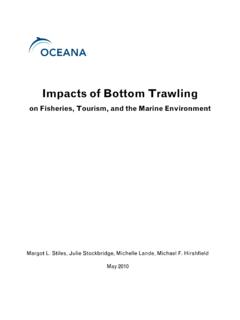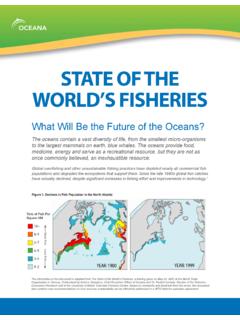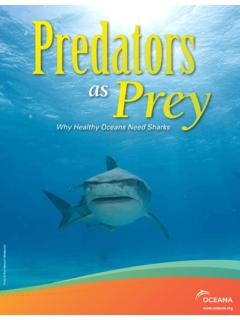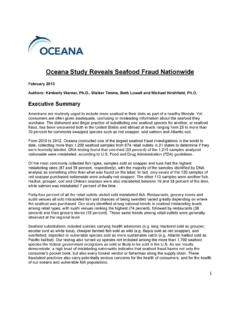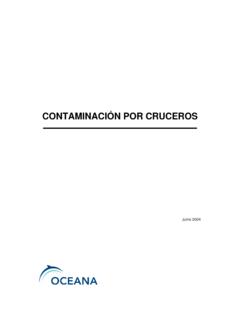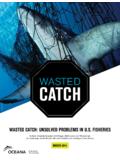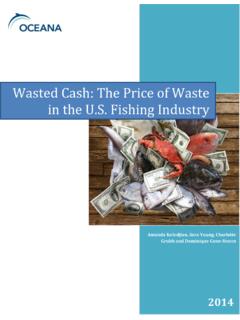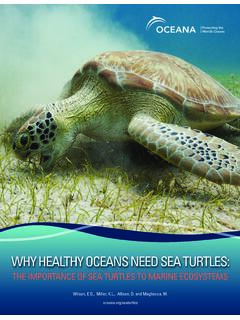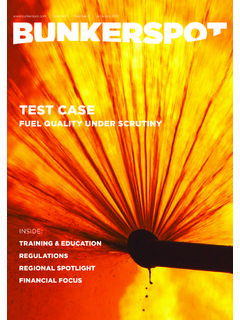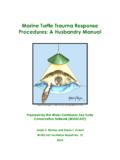Transcription of CONTAMINATION BY CRUISE SHIPS - Oceana
1 CONTAMINATION BY CRUISE SHIPS June 2004 CONTAMINATION BY CRUISE SHIPS Introduction CRUISE ship tourism has experienced massive growth in the last thirty years. During these three decades, the number of people opting to spend their vacation on board one of these vessels has multiplied by 25 and so, as a result, have any associated problems. More than 50 companies control almost 300 CRUISE SHIPS that carry millions of passengers from one point of the planet to another. Some of the most popular tourist destinations are those which, at the same time, are the most sensitive to environmental disturbance. The caribbean , Alaska, the Mediterranean, the Nordic fiords and the coasts of many small islands are subjected to visits from these giant vessels.
2 Their natural beauty is the attraction, but also their Achilles heel, as these spots are very vulnerable. Big CRUISE liners can carry up to 5,000 people, including a crew of more than 1,000, which makes them genuine floating cities. With lengths that exceed 300 metres and gross tonnage of more than 100,000 GRT, onboard facilities include swimming pools, theatres, cinemas, restaurants, shops, saunas, tennis courts, photo processing shops, laundries, dry cleaning and everything a passenger could possibly require during his stay in his floating hotel. But all these activities generate hundreds of tons of waste of every kind, part of which is thrown into the seas and oceans plied by these SHIPS . International legislation on the processing and dumping of this waste barely regulates the activities of CRUISE SHIPS , so tonnes of waste end up in the ocean waters, having hardly been treated.
3 If we were talking about a coastal resort instead of a CRUISE ship , national and international treaties, agreements and legislation would be far stricter, making it obligatory for any effluent generated to be specially processed to prevent the dangerous dumping of faecal water, greywater, hydrocarbons, heavy metals and other toxic substances. However, CRUISE SHIPS can dump all kinds of organic waste and untreated water when they are more than four miles out from the coast. The growing problem caused by this increase in CRUISE ship traffic all over the world has led to some countries, particularly the most frequently visited ones, to start introducing new regulations to try and curb their impact.
4 However, legislation is sadly lacking when it comes to international waters. GENERATION OF WASTE ON BOARD A CRUISE ship It is calculated that a CRUISE ship with a capacity of some 2,000-3,000 passengers can generate some 1,000 tonnes of waste per day (1)which can be broken down as follows: z550,000-800,000 litres of greywater z100,000-115,000 litres of blackwater z13,500-26,000 litres of oily bilge water z7,000-10,500 kilos of garbage and solid waste z60-130 kilos of toxic waste This means that the generation of waste per passenger per day comes to at least 300 litres of greywater, 40 of blackwater, 10 of bilge water, kilos of garbage and 30 grams of toxic waste. Taking into account the number of passengers who use CRUISE SHIPS each year, the amount of waste generated by zone in which these vessels operate (based on data from the year 2000 (2)) would be as follows: BALLAST WATER Another problem is that generated by the large quantity of ballast water used by these vessels.
5 It is thought that a typical CRUISE ship could dump some 70,000 litres of ballast water per day, with the subsequent risk of introducing invasive dinoflagellate species into ecosystems and giving rise to red tides and pathogens. The IMO believes that the dumping of ballast water, which each day carries some 7,000 species from one end of the planet to the other (3), is one of the most serious environmental, health and economic problems generated by maritime traffic. TYPE OF WASTE GENERATED BY CRUISE SHIPS With regard to toxic products, a study (4) quantified the daily generation of these products at some 75 litres of chemicals used in photography processing, 7 litres of used paint, litres of dry cleaning fluids, kilos of fluorescents, kilos of batteries and kilos of medical waste, as well as some 60 litres of chemicals past their expiry date.
6 ENERGY CONSUMPTION AND AIR POLLUTION The fuel consumption of a CRUISE ship is equivalent to 12,000 vehicles, exacerbated by the fact that the type of fuel used by the majority of these vessels is 50 times more toxic than regular fuel. Big merchant vessels and CRUISE SHIPS tend to use lower quality fuel to keep costs down, but this is also the most contaminating fuel. This low-quality product is made up of the heavier hydrocarbon residues that are left over following the crude oil refining process to produce higher quality fuels such as petrol or light oils. A recent article published in the New York Times (5) quantified the air pollution produced by big merchant vessels, such as freighters and CRUISE SHIPS , as equal to that of 350,000 vehicles, and calculated the levels of leads and sulphurs in these fuels at 3,000 times higher than petrol.
7 The smoke from burning fuel in CRUISE ship engines contains suspended particles, sulphurs and carbon and nitrogen oxides including NOx, SO2, CO and CO2 or polycyclic aromatic hydrocarbons (PAHs). (6) This fuel is not only used to actually move the ship along but also to maintain all the electrical systems of this veritable floating city in operation: lights, refrigeration, air conditioning, nightclubs, shops, vending machines, televisions and a plethora of electrical appliances. Air pollution is also caused by waste treatment. Part of the waste is incinerated on board, so CRUISE SHIPS also generate ash and smoke emissions containing toxic substances. As a result of this waste treatment, substances as toxic as polychlorate biphenyls (PCBs), dioxins and furans have been detected in smoke from fuel-burning.
8 CONTAMINATION BY CRUISE SHIPS CRUISE ship spillage can contain toxic substances, hydrocarbons, organic residue and pathogen agents, the potential impact on sensitive areas of which is considerable. A study carried out in Alaska corroborated that 68 of the 70 samples taken from the effluent of CRUISE SHIPS using standard treatment systems exceeded the levels of coliforms in faecal water and/or suspended solids (7). Prior to this, another study carried out in the same American state confirmed that concentrations of pathogens in this spillage may exceed federal limits by between 10,000 and 100,000 times (8). High levels of coliforms were also detected in greywater, as well as heavy metals and dissolved plastics (9), something that is particularly worrying given that this kind of waste is not regulated.
9 The generation of garbage is another pressing problem, as CRUISE SHIPS produce 24% of the total solid waste generated by world maritime traffic (10). Unfortunately, many ports lack the proper installations to receive and process this and other waste generated by vessels. A report by the US government revealed that of the 87 indictments for illegal dumping by CRUISE SHIPS in its waters between 1993 and 1998, 93% included the dumping of hydrocarbons (11). The report also revealed that 69 CRUISE SHIPS from 42 different companies were chronically involved in illegal dumping, submitting false information or not keeping the required records of dumping and processing. And these illegal dumping practices have continued.
10 IS IT POSSIBLE TO STOP THIS CONTAMINATION ? The adoption of technologies to considerably reduce the impact of CRUISE SHIPS on the environment is not only possible but can be achieved at a relatively low cost. Installing systems to treat sewage in these vessels would represent some million dollars per ship . To reduce the volume of waste, there are compacting, shredding, dehydrating and pulverising systems already available which make it easier to store and manage waste until it can be optimally treated. With regard to air pollution, some new SHIPS are already being manufactured with gas turbines which can reduce emissions into the atmosphere by 90%. Proposals have also been made to use less contaminating fuel and to link up to an electrical system when in port to reduce dependency on fuel-burning.
